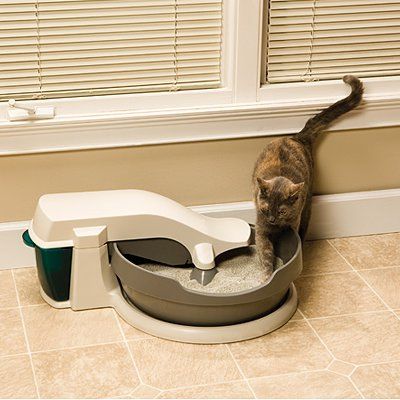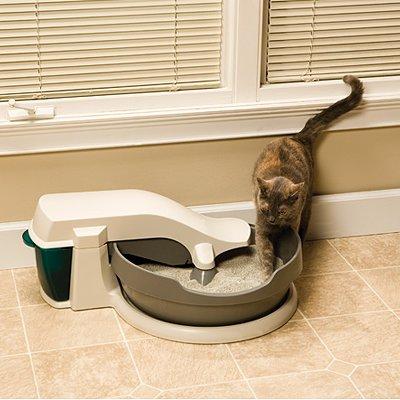New pet parents sometimes assume cats know how to use the litter box. But not all felines understand potty rules. Allowing a cat to make a mess isn't fair to her, or to the carpet!
It can be a challenge to fix litter box lapses because the scent of the mistake lures cats to repeat the offense. Instead, you can litter box train cats and kittens from the beginning with these 5 easy tips.
Pick the Best Box
You'll find a wide variety of litter boxes, from fancy to plain. Your cat won't care how much you spend or if the potty matches your furniture. She wants a box she can easily hop in and out, but large enough her nether regions don't hang out when she poses.
Most boxes are designed with the human's convenience in mind, not the cat's.
-
 Covered boxes prevent litter scattering.
Covered boxes prevent litter scattering. - Covers block the view so cats feel trapped.
- Covers contain but concentrate odor, prompting cats to snub the box.
- Small boxes fit under furniture.
- Big cats "hang over" the side in a small box.
Most standard commercial litter boxes run on the small size, especially for jumbo-size boy cats. Instead, I use a translucent plastic storage bin (without the lid) for my big boy cat, Karma. The high sides help keep litter excavations inside the box, as well as potential urine spray. And for my 17-year-old arthritic girl cat Seren, a similar large storage container but with low sides for easy climbing in and out works well.
 Choose Fantastic Filler
Choose Fantastic Filler
Cats love fine textured filler that's easy on their paws for digging and covering waste. Clay has been one of the most popular fillers because it absorbs liquid and helps contain odor. The newest also "clump" making cleaning the box even easier. Today, a variety of cat box fillers are composed of everything from recycled newspaper, wheat, or corn, to crystals. These may be touted as more environmentally friendly, easier to use, less expensive, or more convenient. Cats only care if the filler feels good to their paws and contains the odor.
When she's used to eliminating outside, she may prefer dirt or leaves, too. Listen to your cat, and she'll often tell you what she prefers.
- Fill the litter box an inch or two deep with the cat box filler.
- If needed, add a top coat of leaves or dirt to help give the cat the right idea.
- Once she's developed allegiance to the box, you can slowly eliminate the leaves.
- Cats dislike change, so stick to what your cat loves.
Find Likely Locations
Just like people, cats have preferences where to potty.
-
 Cats like privacy.
Cats like privacy. - Cats want a quiet spot.
- Cats hate feeling trapped.
- Cats dislike being startled.
- Cats hate eating next to their waste.
Choose a potty spot that has less foot traffic like a back bedroom or large bathroom that's not used every day. Avoid placing the litter box in a corner or under furniture--a room with two doorways is ideal. Switch off the laundry buzzer if you fear the cat may be startled, or that scared kitty may "blame" the box and find a different place to urinate. Be sure the food and water bowls are in a different location than the cat's toilet.
Offer Nice Numbers
Many cats require more than one litter box. You'll absolutely need multiple boxes with multiple cats--I recommend the 1+1 Rule. That's one box for each cat, plus one. Here's why.
- One cat can "guard" a single toilet and prevent other cats from going--it's harder to guard multiple boxes
- Some felines just don't want to "go" after another cat
- Cats may prefer to use one box for urination and another for defecation.
- Old cats and young kittens can't get to the litter box in time--a box on each end of the house or on separate floors helps them do the right thing.
Give Potty Praise
Now what? Simply show your cat the potty place. Scratch with your fingers in the litter to demonstrate what a great potty opportunity you've created. Most adult cats get the idea pretty quickly. For kittens, timing is key, so follow these steps.
-
 Take your kitten to the box after meals, playtime, and naps.
Take your kitten to the box after meals, playtime, and naps. - Place the baby in the box.
- You scratch the litter, and praise when she does the same.
- When she eliminates, praise the cat and give her a treat or play with a favorite toy.
- Leave one fresh deposit as a scent reminder to return to the potty spot.
- Let her climb out of the potty to leave so she'll know how to find her way back.
Every cat is different, of course, so what does your cat prefer? By listening to her location preferences and choosing the right style box and filler, you can create a perfect feline bathroom. Helping her eliminate in the right spot with a little praise will turn on the purrs for her, and that's a reward for you both!






